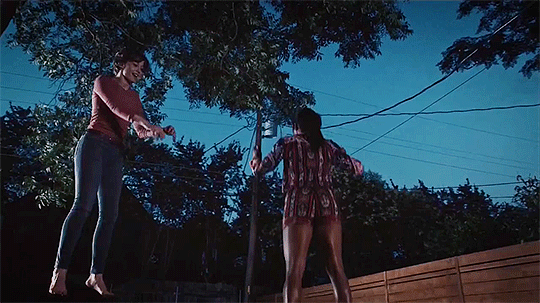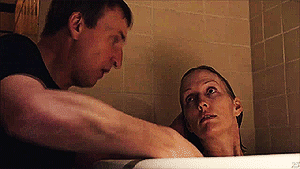After three highly underappreciated seasons, The Leftovers came to an end this past June. As the latest project by the notorious Damon Lindelof of Lost fame, we came to the show by differing means and with differing skepticisms. Bo only came to the show this year out of fear of another show built on mysteries and explaining none. Katie started catching up as season two was airing, a stubborn Lost-defender eager to see what Lindelof would do next.
In the end, we can both agree on one thing: The Leftovers is one of the most brilliant TV shows we have ever seen. Layers upon layers of superbly explored themes connect a large cast of compelling characters. The writing, acting, and directing (thank you, Mimi Leder) gelled to create something truly special. Despite the truly unforgivable lack of respect by the Emmys (one of the biggest mistakes in the history of the awards show), The Leftovers has enjoyed overwhelming critical praise and will be looked back on as one of the best shows ever made.
There are many reasons for this. We could spend hours and tens of thousands of words talking about them. Perhaps we will in the future, either together or on our own. For now, we’re going to focus on what we believe to be the three defining aspects of The Leftovers and the brilliant job the show did with them. Consider this our love letter to The Leftovers, one we hope convinces some of you to watch this remarkable show.

The Many Sides of Grief
The Leftovers is a story about living with trauma.
In some cases, that trauma is tangible and explicit. Nora, one of the story’s two central figures, begins her story having lost her entire family in an instant. Jill, a suburban teenager, has lost her mother to an apocalypse cult called the Guilty Remnant. There are missing daughters, abusive husbands, comatose wives, and suicide attempts.
But like most of The Leftovers, the approach to trauma works on multiple levels. The source of much of the tangible trauma—the “Sudden Departure” in which 2% of the global population inexplicably and instantaneously vanished—also functions as a kind of universal, metaphysical trauma. Two percent of the people were gone, but everyone was upended. The world broke its promise to keep functioning has it always had, and The Leftovers is the story of how everyone tries to cope in the aftermath.
The Leftovers never shows the faintest interest in exploring or solving the mystery behind the Sudden Departure. Just listen to the second season’s theme song if you doubt this. It simply wants to look at how it affects a small group of people. Some ignore their grief over the event in desperation to move past it. The Guilty Remnant represent a section of the population refusing to move on. Characters seek miracles, seek punishment, seek balance between the desire to move on and the need to return to a normalcy lost.
This could have been interesting enough, and made for quite a good show. It’s pretty much what The Leftovers is for its first season. But where the Leftovers really transcends into something special is in its second and third season, when the processing of trauma becomes a collaborative, communal affair.
Grief, in The Leftovers, is nearly always intersectional and public. The way an individual processes their grief always affects someone else, for good or ill. Laurie, a psychologist married to co-protagonist Kevin Garvey, seems to manage her grief in a selfish, destructive fashion. She abandons her family and practice and flings herself into an apocalypse cult that dresses her all in white and forbids her to speak.
John Murphy, chief of the fire department in a town famous for losing no one to the Sudden Departure, processes his grief by exercising control. He lashes out violently at anyone attempting to claim supernatural powers derived from the town. When his daughter goes missing, he eventually shoots the person he suspects to be responsible. There are other examples, of course. But in The Leftovers, grief can be dangerous, and always has collateral damage.
It is this exploration of the many ways human beings process grief that defines the show.
This sounds like it has the potential to be a deeply dark show. People hurt and hurt others in turn. But the real beauty of The Leftovers comes from the fact that it never uses this to become dark, gritty, or nihilistic. Instead, it’s overflowing with empathy, and one of the kindest shows we’ve ever seen. It acknowledges that grief and trauma among a broad group of people often causes them to hurt each other, in a myriad complex of ways. It never denies that fact, minimizes it, or makes excuses.
But it also allows those same characters to tentatively feel around the wounds they’ve caused each other, to slowly make amends, to grow and to help each other cope with grief.

Trauma divides its characters at the start, creating a prickly barrier of loneliness. But in time, it also allows people to listen to each other, learn from each other, and know each other.
Possibly more than any show we’ve ever seen, The Leftovers shows genuine respect towards the concept of grief. There is no judgment by the writers towards a character who wishes to commit suicide, just as there is no judgment towards a character who dives into faith. The Guilty Remnant may be treated harshly by some main characters, but the positives and negatives of their existence are explored with equal validity to those opposing them.
Even many weeks after The Leftovers came to an end, we still find this total lack of judgment or bias stunning, and frankly hard to believe. It is this lack of judgment which helps the show ward off acedia and remain a deeply beautiful show no matter how hard you may cry afterwards. People are people, and valid, and deserve the same respect no matter how they respond to their grief.
That’s not to say the show refuses to judge terrible actions taken because of grief. The Guilty Remnant do something absolutely horrible in season 1. The backlash against them is just as terrible. However, you never fail to understand why or what drove them to those actions. The deeper meaning behind their grief always stands out. You always understand them to be actions of a hurt, angry people coping with a shared trauma, and relate to their response.
Thankfully, this same lack of judgment or bias extends beyond grief to every part of the show, to the same wonderful effect.
Exploring Faith and Belief
The Leftovers is a story about living with trauma. It’s also a story about belief.
The world in The Leftovers is defined by uncertainty. Something awful happened, no one knows why, and no one is ever going to get the answer. The world isn’t what people thought it was. Its shape shifted, its foundation got too many cracks. Old assumptions don’t work. So, whether they admit it or not, everyone in The Leftovers is looking for something new to believe in, some new purpose or shape they can assign the world in order to give it meaning. And, once again, this moves from lonely to communal.
Let’s start with Matt, Nora’s brother.
Matt is an Episcopal priest and the most obvious candidate for a discussion of belief. In the show’s first season he fixates on two things: proving that those who disappeared were not good people (in order to quash rumors of the Rapture) and saving his church. Matt follows a series of elaborate, biblical signs in order to win the money to save his church at a casino. He then loses the church anyway, thanks to a freak accident.
In season two he believes that Jarden, Texas—John Murphy’s spared town—will have the power to wake up his comatose wife. She does wake up; she also leaves him soon after. And in season three, Matt becomes obsessed with the idea that Kevin Garvey is some kind of messiah. He is, but also he’s not.

Matt’s story is many things. But at its heart, it’s a story about how much credence to bestow upon the world. What do you do with a world that lines itself up for you into a sign, but then falls apart again as soon as you read it?
And Matt isn’t alone in this. Kevin’s father also bases his actions around Matt’s belief in Kevin as a messiah. Characters join the Guilty Remnant, the apocalypse cult that Laurie joined, in order to give their world some structure and meaning (although on it’s face a renunciation of meaning, the Guilty Remnant’s big thing, is of course a sort of meaning in and of itself). A character in season one named Holy Wayne goes around hugging the pain out of people. It’s kind of ridiculous—and Wayne himself seem to at least kind of realize this—but it works, because people want it and need it to work.
Some need meaning to explain their grief and loss, to explain a world where millions could just vanish. And so they search desperately for this meaning.
On the other hand, and often opposing the faithful, are those who reject faith and belief entirely. Some of these characters not only reject faith, they impose their lack of faith on others. This creates a great deal of conflict throughout the series. John Murphy stands in opposition to his family. Nora stands in opposition to Matt. Kevin opposes his father’s beliefs, yet as he is gradually revealed to desire meaning for his losses, he ends up on his father’s side. This then puts him in opposition to Nora and others. Relationships evolve, growing or splitting, as each character’s opinion on faith drives their reaction to the events of the series.
The conflict between those who believe and do not believe plays a central role in The Leftovers. Residents of Mapleton and the Guiltry Remnant face off throughout season 1 until the conflict boils over at the end. The question of Jarden’s specialness (having gone untouched by the Sudden Departure) drives the second season. The belief of Kevin as a messiah figure dominates the final season.
All of this, once again, makes it sound as if the show may laugh at or reject faith. It’s hard to imagine any story offering consistent opposition to the faith of characters, especially delivered by the main characters, that doesn’t mock believers. But if anything, it’s the opposite. Belief is fraught on The Leftovers. But it’s also beautiful. There’s nearly nothing on this show that can be known with certainty. But there are things that characters choose to believe in. And they often choose these things together.

Just as The Leftovers depicts many types of grief with no judgment or bias, the question of faith receives the same respect. No “right” answers exist to explain the events of the series. Some ascribe them to a higher purpose or meaning. Others will search for answers in logic and science. Everyone is allowed to belief what they believe, and the show lets the audience draw the same conclusions based on their own belief, or lack thereof. Some events (mostly involving Kevin) may be hard to explain without some supernatural presence, but the balance is never lost.
And what’s more, belief is an ever-changing thing. The largest skeptics become the strongest believers. The most skeptical and rational character on the show considers undergoing a pseudo-scientific process that verges on a suicide attempt. Some of the faithful let go of their need to find a higher purpose and meaning in everything.
The last scene of the series consists of one character sitting at a table, telling a long story to another character. Then the latter character decides whether or not to believe the first. That’s it. That’s how the story ends, with a question of faith both the audience and one of those characters can choose to belief or not believe. No judgment, no bias, no right answer proving either side wrong.
It’s a choice one character makes based on their own desire for belief, and also for love. Which brings us to our last part.
The Love Story at the Center
The Leftovers is a story about trauma and a story about belief. It’s also a love story. In the end, this love story was the focus of the amazing finale.
We’d like to start this section with a caveat. Describing a television show as a “Love Story” is not going to be a successful strategy to get us to watch it. We don’t know if we have cold, cold, hearts of stone or if we’ve watched too many contrived love stories about beautiful twenty-somethings in the city who don’t communicate well. Perhaps we’re just terrible, jaded people who groan at Hollywood romances. But The Leftovers is a love story, and we think it’s quite beautiful because of that, not in spite of it.

The Leftovers sees so many characters trapped inside their own heads. At various points in time they fixate on whether they can believe their reality, become mired in their grief, or obsess over their beliefs. They try to go back or try to move forward, but ultimately can’t because their isolation only traps them further. The only way they can find happiness, it seems, is when they make a decision; to come outside, to share their grief, and to decide with another person what to believe in together.
This takes so many forms over the course of the show. It’s a romantic love story, but many other kinds as well. There’s love between siblings, love between families, love between friends. The Leftovers treats it all as valid, real, deep, and healing. Characters find connections that help them move on or reconnect relationships severed in the grief of the Sudden Departure. Some of our favorite characters, such as Kevin’s daughter Jill, find peace and healing in loves of multiple forms: romantic, maternal, fraternal, and even in platonic friendship.
But the center of the story falls to Kevin and Nora, whose stories literally bookend the final season. They are undoubtedly the main characters of the show, and a romantic connection forms between them from early on. They’re dating by half-way through the first season. One offers to take the other on a vacation to Miami during their second meeting. No matter where The Leftovers took the story, it always centered back on Kevin and Nora.
What makes them work so well is how the show never stops treating them as two separate, unique individuals and people. Nora is one of the most interesting, unique, and fully-realized characters ever seen on television (and Carrie Coon is a national treasure we will defend endlessly against any perceived slight). They have stories independent of each other and different, sometimes conflicting things that they need to work through. They love each other but can be petty and selfish.
Their independent stories are used to great effect in creating the love story so central to The Leftovers. Shared grief and desire to replace the families they lost bring them together. Similar coping mechanisms allows them to relate and grow stronger. Differing responses to questions of faith posed following certain events split them apart, as do their shared character flaws.
The evolving nature of their relationship reflects every aspect of the show, from beginning to end. They face Mapleton’s grief and the Guilty Remnant in their own way, and also as a couple. They face the belief of Jarden the same way, and Matt’s insistence of Kevin as a messiah. Grief over children, grief over lost lovers, their responses to trauma, their responses to faith, they face it all together. Sometimes they agree. Sometimes they disagree in ways which threaten the relationship.

But in the end, The Leftovers is about loving through all this grief and uncertainty and loss. It is not a love story involving fate or soul mates, or a love that was destined to be. Instead it winds up being a story—for Kevin and Nora and for the show writ large—of moving through grief and uncertainty with the people around them, and emerging out the other side to craft a story in which they believe.
The result is a beautiful narrative of trauma, pain, and the ability of everyone as people to heal from it to find a love worth believing in. The result makes for one of the best shows ever made.
Images Courtesy of HBO
[starbox id=”Bo,Katie W”]

